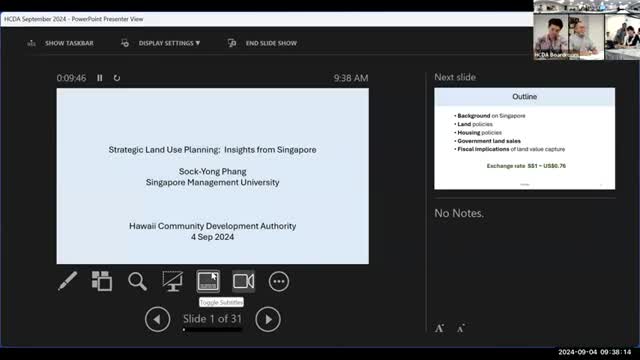Singapore's bold land policies reshape housing amid scarcity
September 05, 2024 | Hawaiʻi Community Development Authority, Executive , Hawaii
This article was created by AI summarizing key points discussed. AI makes mistakes, so for full details and context, please refer to the video of the full meeting. Please report any errors so we can fix them. Report an error »

In a recent government meeting, discussions centered on Singapore's unique land and housing policies, highlighting the challenges posed by the city-state's limited land area of just 730 square kilometers, home to approximately 6 million residents. The meeting emphasized that Singapore's land scarcity necessitates innovative solutions that may seem drastic compared to other nations.
The speaker outlined the historical context of Singapore's land policies, tracing back to the Land Acquisition Act of 1966, which grants the government broad powers to acquire land for public purposes without objection from landowners. This legislation was enacted in response to a housing crisis following World War II, which saw significant overcrowding and a pressing need for redevelopment. By 2005, the state owned 90% of the land, a significant increase from 49% in 1965, aided by land reclamation efforts that expanded Singapore's land area by 25%.
Despite its small size, Singapore has achieved remarkable economic success, being ranked as the world's freest economy by the US Heritage Foundation. However, the meeting underscored that this economic freedom coexists with extensive government intervention in land and housing markets. The discussion also touched on the fiscal implications of land value capture, a strategy employed by the government to harness the increase in land value resulting from public investments.
Overall, the meeting provided a comprehensive overview of how Singapore's land policies are intricately linked to its economic development and urban planning, reflecting the ongoing need for effective management of limited resources in a densely populated environment.
The speaker outlined the historical context of Singapore's land policies, tracing back to the Land Acquisition Act of 1966, which grants the government broad powers to acquire land for public purposes without objection from landowners. This legislation was enacted in response to a housing crisis following World War II, which saw significant overcrowding and a pressing need for redevelopment. By 2005, the state owned 90% of the land, a significant increase from 49% in 1965, aided by land reclamation efforts that expanded Singapore's land area by 25%.
Despite its small size, Singapore has achieved remarkable economic success, being ranked as the world's freest economy by the US Heritage Foundation. However, the meeting underscored that this economic freedom coexists with extensive government intervention in land and housing markets. The discussion also touched on the fiscal implications of land value capture, a strategy employed by the government to harness the increase in land value resulting from public investments.
Overall, the meeting provided a comprehensive overview of how Singapore's land policies are intricately linked to its economic development and urban planning, reflecting the ongoing need for effective management of limited resources in a densely populated environment.
View full meeting
This article is based on a recent meeting—watch the full video and explore the complete transcript for deeper insights into the discussion.
View full meeting
